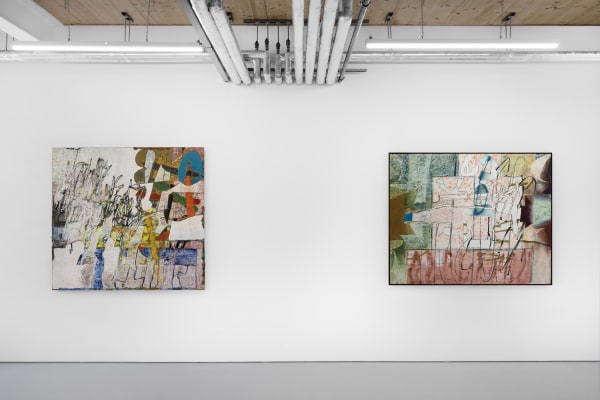Edmond Brooks-Beckman: Sandpaper can't do that
Writing is a mark, letters are a line. Many of Edmond Brooks-Beckman's works include words, names, numbers and symbols that may disappear in the process of painting. The names of people, descriptions of feelings and an ancient language are drawn, but will then be covered as Brooks-Beckman builds up the paintings. Oil is added in swaths and layers, thickening the canvas or paper and often covering what was there before. The paint is then scraped back with a Stanley blade to reveal part of what is underneath the layers. What remains from the presence of those marks is more often not legible. They become values, signifiers, things that defy categorization and yet still carry specific links to language and heritage, like a time capsule.
The process of removal is as essential to the work as the oil paint and the canvas or paper are. The use of the Stanley Blade is a crucial element in the work. The knife means precision: rubbing, sandpapering, no other technique can achieve the kind of detail that these paintings show. The canvases and paper that are the support for Brooks-Beckman's paintings do not look damaged or injured in this process of removal and the grid that underlines it all is still hinted at, still ghostly, almost there: a series of squares, a modernist system, a logic that was useful but also insufficient. And thus, what may look familiar - large, abstract paintings full of action - is actually a foundation for something else.
These paintings are the results of verbs, of movement - layering, carving, painting and cutting, setting up and deconstructing. There's a sense of chaos to that is then not solved, but treated. Making a mess, then cleaning it up, says Brooks-Beckman. When the layers are undone, something is revealed: what viewers see in the work is not the subject matter, from identity to religion to relation, but rather a relationship to that subject matter.
There is a link between the way Brooks-Beckman handles the material and the subjects that inform his work. The concealment and process of discovery relate to ancestry, tradition and ritual. 'What good are roots if you can't take them with you?' Asked Gertrude Stein. Brooks-Beckman responds to this idea, suggesting that roots are not something that moors us in the world. They are the amalgamation of these elements he keeps returning to - language, memory, symbols - and always sees something new in. Roots, Brooks-Beckman's paintings offer, are not something that anchors you: they're something to trace. There is a poetry to that, there is a practice to that. You see your roots, and do not tear away from them: instead, you take them with you, scraping and cutting and searching, until you find something. And perhaps it was always there, it just had to be discovered.
— Orit Gat








